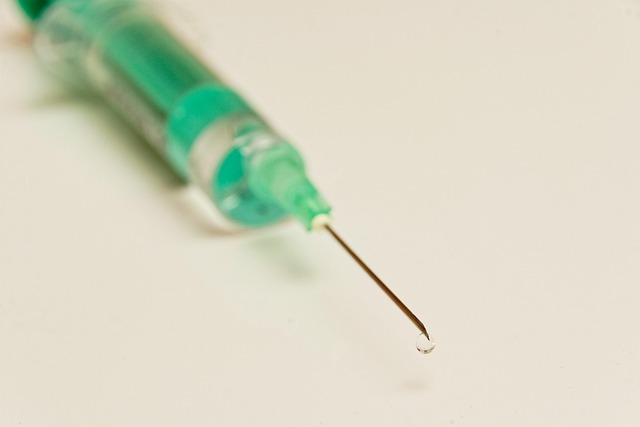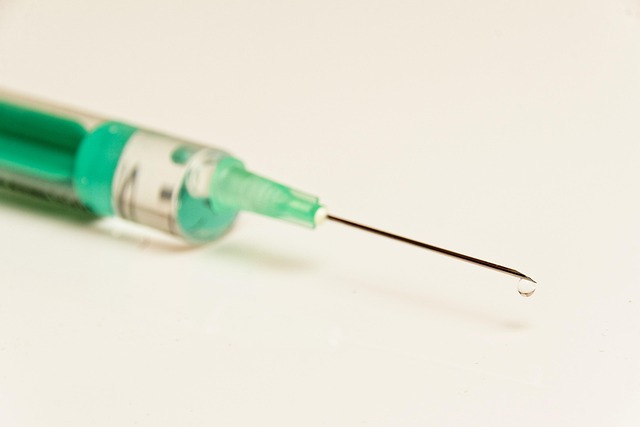Joint Pain Relief: Navigating Costs & Insurance for Corticosteroid Injections

Corticosteroid injections provide swift joint pain relief for conditions like arthritis, tendonitis,…….
In the realm of medical intervention, Corticosteroid Joint Injections (CJIs) have emerged as a powerful tool for managing joint pain and inflammation. This article aims to delve into the intricate world of CJIs, exploring their mechanisms, global impact, economic implications, technological innovations, regulatory framework, and future prospects. By the end of this detailed exploration, readers will possess a comprehensive understanding of CJIs’ significance, current landscape, and potential trajectory in the medical field.
Corticosteroid Joint Injections involve the direct administration of corticosteroids into a specific joint space to reduce inflammation and alleviate pain. Corticosteroids are a class of hormones that mimic the effects of natural steroids produced by the body’s adrenal glands. They possess anti-inflammatory, immune-modulating, and analgesic properties, making them valuable in treating various musculoskeletal disorders.
The injection typically includes a corticosteroid, such as triamcinolone or methylprednisone, mixed with a local anesthetic like lidocaine. This combination provides rapid pain relief and long-lasting anti-inflammatory effects. The procedure is usually performed under ultrasound guidance to ensure accurate placement of the injection into the targeted joint.
The concept of using corticosteroids for joint conditions has a rich history dating back to the 1940s when scientists discovered the powerful anti-inflammatory properties of hydrocortisone. Over the following decades, researchers refined the technique and developed various corticosteroid formulations suitable for injection. The introduction of ultrasound guidance in the late 20th century further improved the accuracy and safety of CJIs.
CJIs play a crucial role in orthopedics, rheumatology, and sports medicine by providing temporary or sustained relief from joint pain, swelling, and stiffness associated with conditions like arthritis, tendinitis, bursitis, and sprains. They offer an alternative to oral corticosteroids, which can have systemic side effects, making CJIs particularly attractive for localized treatment.
Corticosteroid Joint Injections have garnered worldwide recognition and adoption due to their effectiveness in managing joint-related ailments prevalent across diverse populations. The global market for CJI has witnessed steady growth, driven by the rising prevalence of arthritis and other chronic inflammatory conditions, particularly among the aging population.
However, there are notable regional disparities in the availability and utilization of CJIs. Developed countries, such as those in North America, Europe, and parts of Asia-Pacific, generally have better access to advanced medical technologies, including CJI procedures. These regions also exhibit higher rates of adoption due to robust healthcare infrastructure and increased awareness among both patients and healthcare providers.
In contrast, developing nations often face challenges related to limited healthcare resources, lack of specialized training, and lower awareness, resulting in lower rates of CJI usage. However, these countries are witnessing growing interest as healthcare systems evolve and patient expectations rise.
The global CJI market is characterized by intense competition, with several key players offering a range of products, including various corticosteroid formulations and injection devices. The market’s growth is primarily driven by:
Increasing Prevalence of Joint Disorders: The aging population and rising obesity rates contribute to the growing prevalence of arthritis and other joint conditions, driving demand for effective treatment options.
Advancements in Technology: Continued innovation in corticosteroid formulations, delivery systems, and imaging guidance technologies enhance the precision and effectiveness of CJIs.
Improved Healthcare Infrastructure: Enhanced healthcare infrastructure in many regions facilitates better access to advanced medical procedures, including CJIs.
The global Corticosteroid Joint Injections market is substantial and continues to expand. According to recent reports, the market size was valued at approximately $15 billion in 2020 and is projected to reach over $25 billion by 2028, registering a compound annual growth rate (CAGR) of around 7% during the forecast period.
CJIs are generally considered cost-effective compared to other treatment options for certain joint conditions, especially when long-term relief is required. However, reimbursement policies vary significantly across regions, influencing patient access and market dynamics. In many developed countries, CJIs are typically covered by healthcare insurance plans, while in some developing nations, out-of-pocket expenses may be a barrier to access.
The growing interest in CJIs has attracted significant investment from pharmaceutical companies, medical device manufacturers, and biotech startups. These investments drive research and development, improve product quality, and expand distribution channels. The market’s potential for growth presents opportunities for investors seeking exposure to the healthcare sector.
One of the most significant technological advancements in CJIs is the development of more potent and targeted corticosteroid formulations. Modern corticosteroids are designed to provide sustained anti-inflammatory effects while minimizing systemic side effects, ensuring better patient outcomes.
Ultrasound guidance has revolutionized the accuracy and safety of CJI procedures. High-resolution ultrasound machines enable real-time visualization of joint structures, facilitating precise injection placement. This technology reduces the risk of complications, such as tendon damage or infection, associated with incorrect injection techniques.
Injection devices have also evolved, offering improved ease of use and control. Needle-free injection systems, for instance, provide a pain-free alternative to traditional needles, enhancing patient comfort and compliance. Additionally, automated injection devices are being developed to streamline the procedure and reduce procedural errors.
The regulatory landscape governing CJIs varies across jurisdictions. In the United States, for example, corticosteroid injections are regulated by the Food and Drug Administration (FDA), which sets standards for product safety, efficacy, and quality. The FDA approves corticosteroids and injection devices based on rigorous clinical trials and premarket notifications.
In Europe, the European Medicines Agency (EMA) plays a similar role, evaluating and approving pharmaceutical products, including CJI formulations. Other regions have their own regulatory bodies with comparable mandates, ensuring product safety and efficacy through stringent testing and approval processes.
Post-market surveillance is crucial for identifying any unforeseen risks or adverse events associated with CJIs. Regulatory authorities conduct ongoing monitoring, analysis of patient data, and collection of reports from healthcare providers to ensure the continued safe use of these injections. This process enables rapid action in case of safety concerns, such as recall of specific product batches or adjustments to labeling information.
While generally considered safe when administered correctly, Corticosteroid Joint Injections can have potential side effects. Common local reactions include pain, swelling, bruising, and tenderness at the injection site. Systemic side effects are rare but may include elevated blood sugar levels, increased blood pressure, and weakened immune response.
Most local reactions subside within a few days to weeks. To minimize these side effects, healthcare providers offer post-injection care instructions, including rest, ice application, compression, and elevation (RICE protocol). In cases of severe or persistent pain, additional interventions may be required.
Complications are rare but can include infection, tendon rupture, or joint instability. Prompt reporting of adverse events to regulatory authorities is essential for monitoring the safety profile of CJIs and identifying any emerging trends.
The future of CJIs lies in personalized medicine approaches tailored to individual patient needs. Researchers are exploring ways to predict treatment responses, optimize corticosteroid dosages, and develop targeted delivery systems to enhance efficacy while minimizing side effects. Genetic testing and advanced analytics can play a pivotal role in these efforts.
Combination therapies involving CJIs with other modalities, such as physical therapy, exercise programs, or platelet-rich plasma (PRP), are gaining traction. These approaches aim to provide more comprehensive pain relief and functional improvement for patients with chronic joint conditions.
Ongoing research and development in injection technologies focus on improving precision, reducing procedural time, and enhancing patient comfort. Minimally invasive techniques, such as micro-needling or intra-articular delivery systems, are being explored to deliver CJIs directly into the affected joints with minimal trauma.
Addressing healthcare equity is a critical aspect of CJI’s future. Efforts to improve access in underserved regions through innovative distribution models, local manufacturing, and public-private partnerships are essential for ensuring that effective treatment options reach those who need them most.
Corticosteroid Joint Injections represent a significant advancement in the management of joint pain and inflammation. Their global impact, technological innovations, and evolving regulatory landscape highlight their growing importance in modern medicine. As research continues to refine CJI techniques and expand access, this treatment modality is poised to play an even more substantial role in improving patient outcomes and enhancing healthcare systems worldwide.

Corticosteroid injections provide swift joint pain relief for conditions like arthritis, tendonitis,…….

Corticosteroid shots rapidly reduce joint inflammation and pain but carry side effects. Hyaluronic a…….

Corticosteroid injections provide swift joint pain relief for acute and chronic conditions but shoul…….

Corticosteroid shots for joint pain in ankles, wrists, and elbows provide fast anti-inflammatory rel…….

Corticosteroid joint injections provide targeted relief for joint inflammation and pain due to arthr…….

Corticosteroid injections provide swift pain relief and reduced inflammation for arthritis condition…….

Knee joint steroid injections provide temporary (weeks to months) anti-inflammatory relief for arthr…….

Knee joint steroid injections are a targeted treatment for severe rheumatoid arthritis (RA) knee iss…….

Corticosteroid joint injections provide targeted relief for severe joint pain and inflammation by de…….

Corticosteroid injections for arthritis require caution in patients with certain medical conditions…….